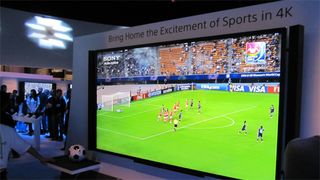World Cup in motion: how football in 4K will change the way we watch TV
The tricky world of experimentation during huge events

The World Cup and the television are star-crossed lovers – the international tournament wouldn't be as popular without a mechanism to watch it, and the biggest sporting event in the world helps drive massive uptake in new flatscreen sales every four years.
But the tie-in goes deeper than that, as the World Cup has been a constant proving ground for new technology that affect the way we watch TV every day.
From the first colour game in 1970, to the all-widescreen tournament in 2006 to 3D, HD and mobile viewing in 2010, new ways to improve the viewing experience are coming at an increasing pace.
In 2014's tournament most viewers won't have been able to escape the 4K / Ultra HD (UHD) message being pumped into their eyes on the constant Sony advertising hoardings – and the electronics company is filming the tournament in the new resolution for the first time in Brazil.
So if you've been enticed into spending a month's wages on a new fancy 4K TV, you might be confused as to why there's no way of watching the tournament in UHD – we find out why that's the case and if 4K is here to stay.
Scaled up
"[Filming the World Cup matches] is a massive HD production, on a massive scale compared to run-of-the-mill Premier League games," David Bush, Sony's marketing director, told us, highlighting the challenge of fitting 12 UHD cameras into an already packed environment.

"One of the obvious challenges [of shooting the matches in 4K], as with 3D, is to work around what's happening on the ground. We need to work around that and take positions alongside the existing cameras," he added.
Get daily insight, inspiration and deals in your inbox
Get the hottest deals available in your inbox plus news, reviews, opinion, analysis and more from the TechRadar team.
Sony is the sole creator of footage from the World Cup, meaning it's got to send high-quality HD footage of 64 games around the world to billions of people. While it's got a team of 300 staff in 12 locations to handle that, the same group of producers, engineers and more have to manage the project of editing the separate 4K footage too.
"There is a limited amount of cross pollination [between HD and 4K], where with one or two HD positions we'll take that feed and up-convert it to 4K, but it's mostly native capture. Pitchside interviews would be a good example, but it's mainly completely separate." said Bush.
3D fizzle
It's easy to see a comparison between 4K and 3D footage; the same amount of effort went into putting 3D cameras in stadia in 2010, and yet the technology seems to have entirely fizzled out.
However, rather than being another 3D fizzle, Bush personally believes that 4K could lead to an uptake in the technology, being a 'Trojan horse' for the tech.
"The most obvious comparison is what we did in 2010 with 3D, where we shot a number of games live in 3D," he said of the current trials. "At that time the technology was a similar point in the [adoption] curve [as 4K], with a lot of consumer awareness and interest."

"[3D TV penetration] isn't at the level we'd anticipated or hoped, but there's still a lot of room for it to re-emerge still.
"One aspect is the glasses are an obstacle as a lot of TVs needed active [glasses]. More recently passive viewing has become more popular and that makes it more comfortable [to watch 3D] and therefore less of an obstacle."
Despite the lack of 4K footage, Bush still thinks that this World Cup is going to be a great chance for consumers to see the benefits of 4K, as on top of filming three matches in full 4K, the brand will also be sending back daily 2-3 minute UHD highlights to retailers to showcase the technology.
"Obviously the amount of 4K content people will be able to see this time around is going to limited (compared to the future)," admitted Bush.
"However seeing is believing. There will always be early adopters who are technically interested in the improvements in dynamic range, colour performance and so on. But the mass audience is persuaded by experiencing 4K content. So we're trying to make it as widespread as possible."
So where is it?
But the bigger question most will have when it comes to 4K: why isn't it available on the TV alongside the HD channels? The reasons are pretty varied, but the main problem is that very few broadcasters have experience with the technology, meaning large scale trials like this are crucial for the future of UHD.
"It's down to individual country issues and their rights – there isn't a separate 4K rights package," said Bush.

"The broadcasters in each territory that have rights to the HD feed have been offered 4K as well by Fifa."
Many have taken this option – for instance, the UK's BBC has an in-house trial of the technology, and will use the 4K signal to decide whether it's viable as a new channel.
Local network Globo in Brazil is going to put up large screens around the Rio neighbourhood to showcase the 4K technology too, but it all shows that the likely timeframe of 2016 for 4K broadcasts still seems like the earliest point we'll see the technology on our set-top boxes.
It's entirely feasible that we never get a 4K channel in the traditional way, as the more data-rich signal obviously requires greater power to transmit. It will also need yet another change in the set-top box under your TV to handle UHD, but Bush is confident that the industry has done enough to cope.
"Getting 4K feeds produced and transmitted is something we've trialled a number of times and we've overcome the tech hurdles. The bottleneck is still in the home: there are very few decoders [that can handle the 4K signal], which is partly why some broadcasters are seeing this as a technology trial.
"In terms of bandwidth, there's four times the data to manage compared to HD signals. But we're waiting for the development of new compression coding and decoding, like HEVC (High Efficiency Video Coding), which is one of the first products to make [transmitting 4K] a practical reality.
"With that it's now possible to transmit 4K signals at not much more bandwidth than HD."
Will 4 become 8?
So does this mean that whether 4K TV is sent over the airwaves or through another medium (such as through the internet; Netflix is ramping up its UHD content already and while it doesn't show live sport, it wouldn't be hard for a provider to do the same if the required speeds are found) that we've reached the limit of resolution for our TVs? Is there a want, or even a need, for anything higher?
The next generation could be 8K: Japanese broadcaster NHK has been trialling the new format, which is 16 times the resolution of Full HD. The provider shot some scenes from last year's Confederations Cup and will be shooting a small amount of the World Cup in Brazil as a trial for the technology.
So does Sony think that this is the future of TV resolution, and if so, is it worth buying a 4K TV if there's going to be a new format in the future?
"There's a project looking at 8K in Japan, which Sony is a part of," said Bush. "I think we've got a way to go [with regards to 8K content] as we're focused on 4K at the moment.
"We're interested in that topic but it's not a natural step at this point in our minds – it's less clear if 8K represents a quantum leap forward over 4K, which we're still focused on getting to widespread availability – there's a way to go before we get to that point."

Gareth has been part of the consumer technology world in a career spanning three decades. He started life as a staff writer on the fledgling TechRadar, and has grown with the site (primarily as phones, tablets and wearables editor) until becoming Global Editor in Chief in 2018. Gareth has written over 4,000 articles for TechRadar, has contributed expert insight to a number of other publications, chaired panels on zeitgeist technologies, presented at the Gadget Show Live as well as representing the brand on TV and radio for multiple channels including Sky, BBC, ITV and Al-Jazeera. Passionate about fitness, he can bore anyone rigid about stress management, sleep tracking, heart rate variance as well as bemoaning something about the latest iPhone, Galaxy or OLED TV.
Most Popular

